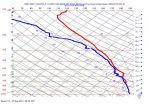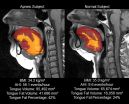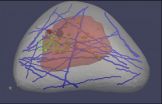(Press-News.org) Among patients ages 50 to 69 years who underwent aortic valve replacement with bioprosthetic (made primarily with tissue) compared with mechanical prosthetic valves, there was no significant difference in 15-year survival or stroke, although patients in the bioprosthetic valve group had a greater likelihood of reoperation but a lower likelihood of major bleeding, according to a study in the October 1 issue of JAMA.
Approximately 50,000 patients undergo aortic valve replacement annually in the United States. In older patients, bioprosthetic valves pose a low lifetime risk of reoperation for structural degeneration and avoid many of the complications associated with mechanical prostheses; bioprosthetic valves are therefore recommended in patients older than 70 years. The optimal prosthesis type for younger patients is less clear, according to background information in the article.
Yuting P. Chiang, B.A., of The Mount Sinai Hospital, New York, and colleagues used a statewide administrative database to quantify differences in long-term survival, stroke, reoperation, and major bleeding episodes after aortic valve replacement according to prosthesis type. The analysis included 4,253 patients ages 50 to 69 years who underwent primary isolated aortic valve replacement using bioprosthetic vs mechanical valves in New York State from 1997 through 2004. Median follow-up time was 10.8 years; the last follow-up date for mortality was November 30, 2013.
The researchers found no significant difference in long-term survival or stroke rates. Fifteen-year survival was 60.6 percent in the bioprosthesis group compared with 62.1 percent in the mechanical prosthesis group. The cumulative incidence of stroke at 15 years was 7.7 percent for patients who received a bioprosthetic valve, compared with 8.6 percent for those who received a mechanical prosthetic valve.
Bioprostheses were associated with a significantly higher rate of aortic valve reoperation than mechanical prostheses: the cumulative incidence of aortic valve reoperation at 15 years was 12.1 percent in the bioprosthesis group and 6.9 percent in the mechanical prosthesis group.
Mechanical prostheses were associated with a significantly higher rate of major bleeding at 15 years compared with bioprostheses: 13.0 percent for the mechanical prosthesis group vs. 6.6 percent for the bioprosthesis group.
"The absence of a significant survival benefit associated with one prosthesis type over another focuses decision making on lifestyle considerations, including the burden of anticoagulation medication and monitoring, and the relative risks of major morbidity—primarily stroke, reoperation, and major bleeding events," the authors write.
They add that these findings suggest that bioprosthetic valves may be a reasonable choice in patients 50 to 69 years of age.
INFORMATION:(doi:10.1001/jama.2014.12679; Available pre-embargo to the media at http://media.jamanetwork.com)
Editor's Note: Please see the article for additional information, including other authors, author contributions and affiliations, financial disclosures, funding and support, etc.
Study compares long-term outcomes for types of aortic valve replacements
2014-09-30
ELSE PRESS RELEASES FROM THIS DATE:
Medical professional liability claims and esophageal cancer screening
2014-09-30
An analysis of liability claims related to esophageal cancer screening finds that the risks of claims arising from acts of commission (complications from screening procedure) as well as acts of omission (failure to screen) are similarly low, according to a study in the October 1 issue of JAMA.
Endoscopic screening for esophageal cancer has been recommended for patients with chronic symptoms of gastroesophageal reflux disease, but only if they have additional risk factors. Surveys of gastroenterologists indicate that concern about litigation for missing a cancer may drive ...
Biodiversity in the Mediterranean is threatened by alien species
2014-09-30
Millions of tourists visit the Mediterranean each year, but its deep-blue waters host the largest invasion currently underway on Earth. Almost 1,000 alien species, including fish, crustaceans, and algae are now established from other seas through human activities. In the open-access journal Frontiers in Marine Science, a multinational team of researchers analyzed data from a new information system developed by the European Commission to show how the introduction of alien species has changed the native biodiversity within the Mediterranean.
A hotspot for marine biodiversity, ...
Clinical trial finds virtual ward does not reduce hospital readmissions
2014-09-30
TORONTO — A virtual ward, a new model of care that provides support to high-risk and complex patients in the community for a few weeks after discharge from hospital, did not prevent hospital readmissions as hoped in a clinical trial in Toronto.
Hospital readmissions are common and costly and no intervention has reliably reduced them. Virtual wards, pioneered in Britain 10 years ago, were thought to have the potential to reduce readmissions, but had not been rigorously evaluated by researchers.
Dr. Irfan Dhalla, a physician at St. Michael's Hospital, led a randomized trial ...
Researchers show EEG's potential to reveal depolarizations following TBI
2014-09-30
CINCINNATI—The potential for doctors to measure damaging "brain tsunamis" in injured patients without opening the skull has moved a step closer to reality, thanks to pioneering research at the University of Cincinnati (UC) Neuroscience Institute.
The research team, led by Jed Hartings, PhD, research associate professor in the department of neurosurgery at the UC College of Medicine, has shown that spreading depolarizations—electrical disturbances that spread through an injured brain like tsunami waves—can be measured by the placement of electroencephalograph (EEG) electrodes ...
NASA's Swift mission observes mega flares from a mini star
2014-09-30
On April 23, NASA's Swift satellite detected the strongest, hottest, and longest-lasting sequence of stellar flares ever seen from a nearby red dwarf star. The initial blast from this record-setting series of explosions was as much as 10,000 times more powerful than the largest solar flare ever recorded.
"We used to think major flaring episodes from red dwarfs lasted no more than a day, but Swift detected at least seven powerful eruptions over a period of about two weeks," said Stephen Drake, an astrophysicist at NASA's Goddard Space Flight Center in Greenbelt, Maryland, ...
NASA's HS3 looks Hurricane Edouard in the eye
2014-09-30
NASA and NOAA scientists participating in NASA's Hurricane and Severe Storms Sentinel (HS3) mission used their expert skills, combined with a bit of serendipity on Sept. 17, 2014, to guide the remotely piloted Global Hawk over the eye of Hurricane Edouard and release a sonde that rotated within the eye as it descended and fell into the eyewall of the storm at low levels.
NASA's HS3 mission has returned to NASA's Wallops Flight Facility on the Eastern Shore of Virginia for the third year to investigate the processes that underlie hurricane formation and intensity change ...
Study shows that tongue size and fat may predict sleep apnea risk in obese adults
2014-09-30
DARIEN, IL – A new study of obese adults is the first to show that those who have obstructive sleep apnea have a significantly larger tongue with a higher percentage of fat than obese controls. This may provide a mechanistic explanation for the relationship between obesity and sleep apnea.
Results show that obese participants with sleep apnea had significantly greater tongue volumes, tongue fat and percentage of tongue fat than obese controls without sleep apnea, after adjusting for potential confounders such as age, body mass index (BMI), gender and race. Further analysis ...
Ultrafast remote switching of light emission
2014-09-30
This news release is available in German.
The researchers etched a photonic crystal around several quantum dots in a semiconductor layer. Quantum dots are small structures that spontaneously emit light as a consequence of atomic processes. If a short laser pulse is fired at the photonic crystal, its refractive index is modified and the quantum dot experiences a change in the electromagnetic field around it. This change can speed up or slow down the emission of light by the dot. As soon as the refractive index recovers its usual value, the dot emits light again ...
'Virtual breast' could improve cancer detection
2014-09-30
Next to lung cancer, breast cancer is the leading cause of cancer death in women, according to the American Cancer Society. That's why so many medical professionals encourage women to get mammograms, even though the tests are imperfect at best: only a minority of suspicious mammograms actually leads to a cancer diagnosis.
That results in lots of needless worry for women and their families—not to mention the time, discomfort and expense of additional tests, including ultrasounds and biopsies.
Recently, a different type of test, ultrasound elastography, has been used ...
Rehospitalization in younger patients
2014-09-30
Older adults often are readmitted after hospitalization for heart failure, pneumonia, and acute myocardial infarction, a significant issue that has caused Medicare to target hospitals with high 30-day readmission rates for financial penalties. Older adults are also often admitted for reasons other than the original hospitalization. This vulnerability to readmission has been referred to as "post-hospital syndrome." However, whether younger patients also experience a similar pattern of readmission has not been well studied.
In a large cohort study, Isuru Ranasinghe and ...





